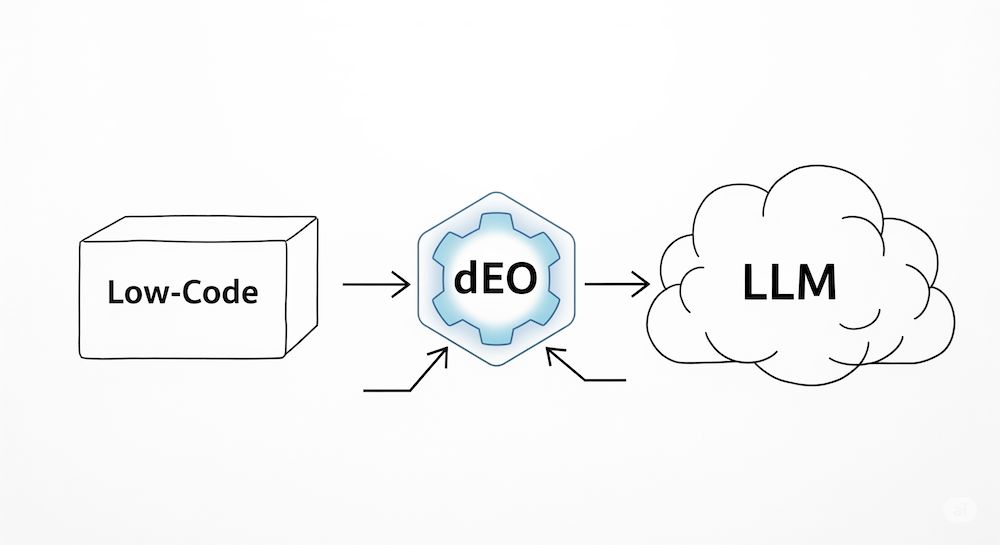
The Next Step: Unifying Logic, Structure, and Language
The Synthesis: Giving the Genie a Workshop.
14 July 2025
In this series, we've journeyed through the evolution of software creation. We've seen the trade-offs at each stage:
• 𝗧𝗿𝗮𝗱𝗶𝘁𝗶𝗼𝗻𝗮𝗹 𝗖𝗼𝗱𝗲: Powerful but slow and rigid.
• 𝗟𝗼𝘄-𝗖𝗼𝗱𝗲: Fast but limited by a "glass ceiling."
• 𝗟𝗟𝗠𝘀: Magically fast but lacking context and architectural stability.
Each paradigm solved the problems of the last but created new ones. The next logical step is not another trade-off, but a synthesis — a new paradigm that combines the strengths of what came before.
This is the purpose of the dEO (Dynamic Executable Ontology) paradigm. It is designed to be the living "world model" that LLMs lack, and the flexible, evolving architecture that Low-Code can't provide.
Think of it this way: if an LLM is a magical genie, the dEO is the workshop you give the genie to build in.
1. 𝗜𝘁 𝗣𝗿𝗼𝘃𝗶𝗱𝗲𝘀 𝘁𝗵𝗲 𝗕𝗹𝘂𝗲𝗽𝗿𝗶𝗻𝘁 (𝗦𝗼𝗹𝘃𝗶𝗻𝗴 𝘁𝗵𝗲 𝗖𝗼𝗻𝘁𝗲𝘅𝘁 𝗣𝗿𝗼𝗯𝗹𝗲𝗺): The dEO is a living graph of the entire system — its components, rules, and relationships. When you ask an LLM agent to add a feature, it can first read this graph. It has full, persistent context of the entire application. It knows what exists, how things are connected, and what the impact of a change will be. This grounds the LLM, preventing inconsistencies and hallucinations.
2. 𝗧𝗵𝗲 𝗕𝗹𝘂𝗲𝗽𝗿𝗶𝗻𝘁 𝗶𝘀 𝗙𝗹𝗲𝘅𝗶𝗯𝗹𝗲 (𝗦𝗼𝗹𝘃𝗶𝗻𝗴 𝘁𝗵𝗲 𝗚𝗹𝗮𝘀𝘀 𝗖𝗲𝗶𝗹𝗶𝗻𝗴 𝗣𝗿𝗼𝗯𝗹𝗲𝗺): Unlike a Low-Code platform, this blueprint isn't rigid. The dEO itself is designed to be changed. The LLM agent doesn't just read the plan; it can write to it. It can add new components (monads) and define new relationships, safely extending the architecture without breaking the core.
This creates a powerful, virtuous cycle:
• 𝗗𝗲𝘃𝗲𝗹𝗼𝗽𝗲𝗿𝘀 use natural language to direct LLM agents.
• 𝗟𝗟𝗠 𝗮𝗴𝗲𝗻𝘁𝘀 interact with the dEO graph, using it as a stable source of truth to execute tasks.
• The 𝗱𝗘𝗢 𝗴𝗿𝗮𝗽𝗵 evolves with each change, growing more complex and capable over time.
This synthesis gives us the best of all worlds: the linguistic power and speed of LLMs, the accessibility of a modular approach, and the structural integrity of a formal architecture. It's the foundation for the next generation of software creation.
But how does this new approach stack up against the old ones? In our next post, we’ll do a direct, head-to-head comparison.
#AI #SoftwareArchitecture #LLM #LowCode #Innovation #Ontology #CognitoOne #dEO